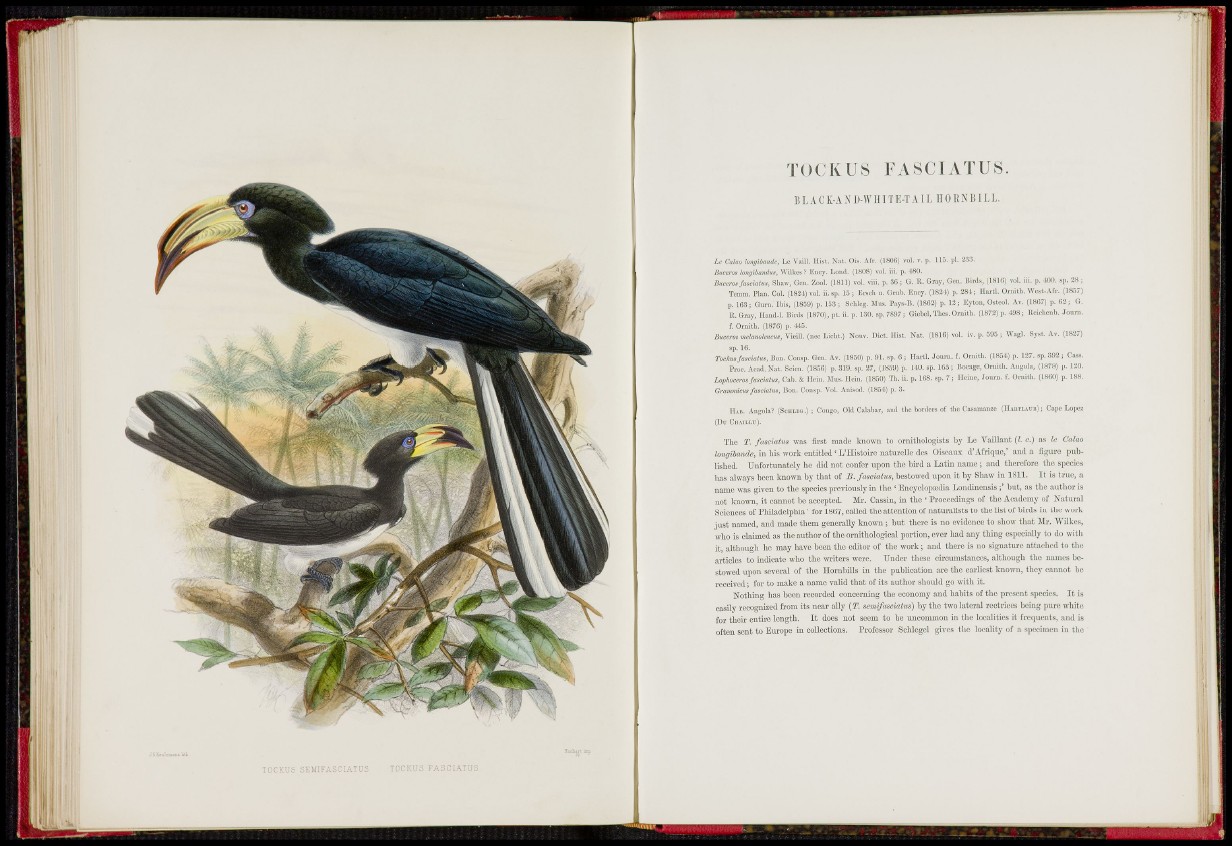
I 0 C K U 5 SEMIFASCiATÜS T0 C K U 3 FASCIATUS
TOCKUS FASCIATUS.
B L A C K-A >; I)-W II 1T E-T A 11, II 0 K N lì 11, L,
Le Calao lonyibimde, Le Vaili. Ilist. ^'•at, Ois. Al'v. (1806) vol. v. p. 115. pl.
Baceros longibandiis, \^•ilkcs ? lîncy. Lond. (1808) vol. iii. p. 4«ü.
Buceros fasciali Shaw, Gen, Zool. (1811) vol. viii. p. 30; Ci. 11. Gray, Gcu, Bird.s, (1816) vol, iii. p. -100. sp. 28 ;
Temm. Plan. Col. (182-1) vol. ii. sp. 15 ; Ersch u. Grub. Eacy. (1821) p. 284 ; llavtl. Oriiith, Wcst-Afr. (1857)
p. 163; Gurn. Ibis, (1859) p. 153; SoMeg. Mus. Pays-B. (18C2) p. 12; lîyton, Ostcol. Av. (1867) p. 62; (i.
R. Gray, Itaiid-l. Biixls (1870), pt. ii, p. 130. sp.7897; Gicbcl, Thés. Oruitli. (1872) p. 498; lleichenb. Jourii.
f. Ornitli. (1876) p. 4-1.5-
ßäceros melarwleucus, Vicill. (nec Licht.) Nouv. Dict. llist. Nat. (1816) vol. iv. p. 5!)5 ; Wagl. Sy«t, Av. (1827)
sp. 16.
Tockusfusciaius, Bou. Consp. Gcn. Av. (1850) p. 91. sp. 6 ; llartl. Jouvn. f. Oniith. (1854) p. 127. sp. 392 ; Gass.
Proc. Acad. Nat. Seien. (1856) p. 319. sp. 27, (1859) p. Mû. sp. 163 ; Bocage, Ornith. Angola, (1878) p. 123.
Lophocerosfascialus, Cab, & Hein. Mus. Hein. (1850) Th. ii. p. 168. sp. 7; llc-ine, Journ. f. Ornith. (1860) p. 188.
Gi-rmmicus fasciatus, Bon, Consp. Vol. Anisod. (1854) p. 3-
U.VK. Angola? (ScnLiso.) ; Congo, Old Calahar, and tlie borders of the Casamanze (IIAKTL.VUB); Cape Lopoz
(Du Cn.\ir.r,u).
The 2'. fasciatus was first made known to ornithologists by I x Vaillant [1. c.) as le Calao
in bis work entitled ' L'Histoire natuvclle des Oiscaux d'Afdciue,' and a figure published.
Unfortunately he did not confer upon the bird a Latin name ; and tliercforo the species
lias always been known by that of J3. fasciatus, bestowed upon it by Shaw in 1811. It is true, a
name was giyen to the spceies previously in the ' Encyclopaidia Londinensis but, as the author is
not Icnown, it cannot be accepted. Mr. Cassin, in. the ' Proceedings of the Acadcmy of Natural
Sciences of Philadelphia' for 1867, eallcd the attention of naturalists to the list of birds in the work
just named, and made them generally known; but there is no evidence to show that Mr. Wilkes,
who is claimed as the author of the ornithological portion, ever had any thing especially to do with
it, although he may have been the editor of the work; and there is no signature attached to the
articles to indicate who the writers were. Under those circumstanccs, although the names bestowed
upon several of the Uornbills in the publication are the earliest known, they cannot be
received; for to make a name valid that of its author should go with it.
Nothing has been recorded concerning the economy and habits of the present species. It is
easily recognized from its near ally {T. semifasciatus) by the two lateral rectrices being pure white
for their entire length. It docs not seem to be uncommon in the localities it frequents, and is
often sent to Europe in collections. Professor Schlcgel gives the locality of a specimen in the